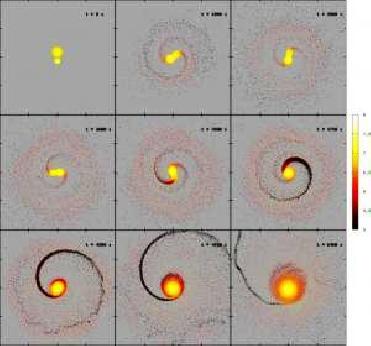
The temporary hydrodynamic development (projection in the X-Y plan) of the binary system made up of a helium white dwarf and the core of a red giant. University of Granada Photo.
GRANADA (BNS): Scientists of the department of Theoretical and Cosmos Physics of the University of Granada in Spain recently conducted a research work, where they have analysed the chemical composition and the evolutionary state of spectral type R carbon stars to try to explain the origin of the carbon enrichment present in its atmosphere.
According to a press release by the University of Granada, type-R stars are peculiar red giant stars, as they show a higher presence of carbon than oxygen in their atmosphere.
Type-R stars are classified into hot-R stars and cold-R stars, depending on their effective temperatures.
The study has determined the chemical composition of a 23 type-R star sample (both hot and cold), using spectrums in the optics with high-spectral resolution, in order to obtain information about the origin of this type of stars, as reported in the release.
Numeric simulation were carried out for the first time of the most favourable scene for the formation of a hot-R stars i.e.; the fusion of a helium white dwarf with a red giant.
With the research work the scientists have come to a conclusion that cold-R stars are identical to type-N stars (or normal carbon stars) but hot-R stars are different.
The research was conducted by Olga Zamora S�nchez and supervised by professors Carlos Abia and Inmaculada Dom�nguez. The scientists have also studied the essential observational features of type-R stars (distribution in the Milky Way, kinematics, luminosity, etc.).
The scientists of the University of Granada are of the viewpoint that this type of study has no immediate applications but the information obtained could be very valuable in the future as carbon is very important for the possible development of life in the Universe.
 Previous Article
Previous Article Next Article
Next Article












The Indian Air Force, in its flight trials evaluation report submitted before the Defence Ministry l..
view articleAn insight into the Medium Multi-Role Combat Aircraft competition...
view articleSky enthusiasts can now spot the International Space Station (ISS) commanded by Indian-American astr..
view article